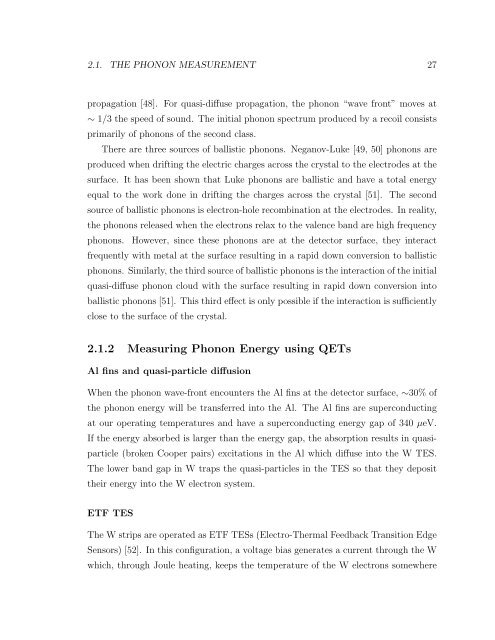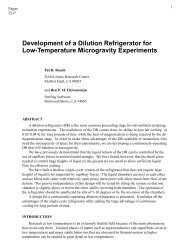cdms-ii - CDMS Experiment - University of California, Berkeley
cdms-ii - CDMS Experiment - University of California, Berkeley
cdms-ii - CDMS Experiment - University of California, Berkeley
Create successful ePaper yourself
Turn your PDF publications into a flip-book with our unique Google optimized e-Paper software.
2.1. THE PHONON MEASUREMENT 27<br />
propagation [48]. For quasi-diffuse propagation, the phonon “wave front” moves at<br />
∼ 1/3 the speed <strong>of</strong> sound. The initial phonon spectrum produced by a recoil consists<br />
primarily <strong>of</strong> phonons <strong>of</strong> the second class.<br />
There are three sources <strong>of</strong> ballistic phonons. Neganov-Luke [49, 50] phonons are<br />
produced when drifting the electric charges across the crystal to the electrodes at the<br />
surface. It has been shown that Luke phonons are ballistic and have a total energy<br />
equal to the work done in drifting the charges across the crystal [51]. The second<br />
source <strong>of</strong> ballistic phonons is electron-hole recombination at the electrodes. In reality,<br />
the phonons released when the electrons relax to the valence band are high frequency<br />
phonons. However, since these phonons are at the detector surface, they interact<br />
frequently with metal at the surface resulting in a rapid down conversion to ballistic<br />
phonons. Similarly, the third source <strong>of</strong> ballistic phonons is the interaction <strong>of</strong> the initial<br />
quasi-diffuse phonon cloud with the surface resulting in rapid down conversion into<br />
ballistic phonons [51]. This third effect is only possible if the interaction is sufficiently<br />
close to the surface <strong>of</strong> the crystal.<br />
2.1.2 Measuring Phonon Energy using QETs<br />
Al fins and quasi-particle diffusion<br />
When the phonon wave-front encounters the Al fins at the detector surface, ∼30% <strong>of</strong><br />
the phonon energy will be transferred into the Al. The Al fins are superconducting<br />
at our operating temperatures and have a superconducting energy gap <strong>of</strong> 340 µeV.<br />
If the energy absorbed is larger than the energy gap, the absorption results in quasiparticle<br />
(broken Cooper pairs) excitations in the Al which diffuse into the W TES.<br />
The lower band gap in W traps the quasi-particles in the TES so that they deposit<br />
their energy into the W electron system.<br />
ETF TES<br />
The W strips are operated as ETF TESs (Electro-Thermal Feedback Transition Edge<br />
Sensors) [52]. In this configuration, a voltage bias generates a current through the W<br />
which, through Joule heating, keeps the temperature <strong>of</strong> the W electrons somewhere




